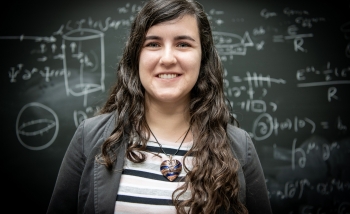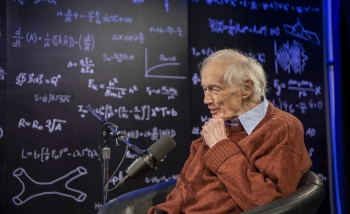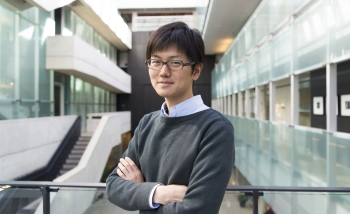For a theoretical physics PhD student, Sebastian Mizera has a predilection for the tangible. He first ventured into physics because he who wanted to know how his computer worked. As a math undergrad at Cambridge University, he joined a cancer research collaboration because he wanted to put his learning to use.
Even his latest research – working with Gluskin Sheff Freeman Dyson Chair Freddy Cachazo to uncover new mathematical structures for quantum fields and particles – has a practical bent. If it works, it could simplify the complex calculations that are used to plan, and decipher, high energy particle physics experiments around the world.
“It was always playing the same game, asking the question ‘Why?’” says Mizera, who grew up in Krakow, Poland. “I was really curious about how things work on this very fundamental level.”
Yet, if you were to sit next to him on an airplane, the affable 25-year-old would weigh up his answer before telling you what he does for a living. If he wants to chat, he’ll tell you he’s a physicist. If he doesn’t, he’ll say he’s a mathematician.
Perimeter PhD student Sebastian Mizera explores new approaches to quantum field theory.[/caption]
Both answers are honest (although he considers himself a physicist first), but they tend to elicit vastly different responses: physics invites questions; math, he says, shuts people down. “People will always tell you that they hate math, and there’s a reason for that. They hate it because of the way it was taught, not because of what it is,” he says.
Math and physics have not only fuelled his trajectory from Poland to the UK to Canada; they also powered his career from gravitational physics into quantum field theory (QFT).
Along the way, he took a brief detour to take an internship at Cancer Research UK, where he helped optimize algorithms and data analysis software. Mizera loved the experience, and, as usual, his curiosity led to surprising places: he helped devise a new way to apply inverse problem theory to an existing imaging method. His new approach led to a significant increase in the resolution of the imaging technique, which could one day lead to earlier diagnoses.
As a budding mathematician and physicist, it was an opportunity to work on something immediate and concrete. “This was the time where I could apply physics to solving some actual problems that could affect people in my lifetime,” he says.
Now, his focus is set on a much longer timeline. He is part of a global effort, led at Perimeter by Cachazo, to reformulate how scientists calculate the scattering amplitudes that map out particle interactions. Why would they want to do that? Because research is suggesting that the current method – using Feynman diagrams – is more complicated than it needs to be.
Feynman diagrams essentially put the mathematical terms into a graphical language, but the method is full of redundancies: after slogging through long and complex calculations, researchers can often find that the answer was relatively simple.
In recent years, there has been a surge in efforts to find a way to map particle interactions without Feynman diagrams. Researchers are exploring the idea that particle interactions arise from the geometry of spacetime. By translating particle interactions into geometrical terms (such as multidimensional shapes) instead of Feynman diagrams, they hope to identify more efficient methods of computation.
“It’s as if nature is trying to tell you something,” says Mizera, who spent two summers at Perimeter as an undergraduate researcher before deciding to pursue his PhD here.
“In the field of scattering amplitudes, these kinds of simpler objects have been popping up in recent years very often. That’s what leads us to believe we are on the right track to trying to understanding the QFT better, on a deeper level.”
He knows it’s hard stuff to wrap your head around – even for a physicist. When he does fly home to Poland to see his parents (who are architects), twin sister (a landscape architect), and younger sister (currently doing film studies), he tries to bring them up to speed on his research. It’s not always easy.
“Last time, I had this new work coming out and it was full of diagrams. I was trying to explain to them, but to a non-physics person, it doesn't mean much,” he said with a good-natured shrug. “But I think they appreciate that I’m working on something important.”
The science: An unexpected connection
As a PhD student, Sebastian Mizera is working under the supervision of Perimeter Faculty member Freddy Cachazo. Cachazo and his collaborators are trying to reformulate quantum field theory (QFT) so that researchers can replace Feynman diagrams with a more efficient method. Mizera’s latest work, published as a pre-print on the arXiv in June, outlines one possible approach.
Mizera has uncovered a deep connection between the scattering amplitudes of two kinds of particles: gluons (a fundamental particle that binds quarks inside protons and neutrons) and gravitons (a hypothetical particle from QFT responsible for transferring the force of gravity). The work links two seemingly unrelated research projects.
The first comes from string theory, which reduces all elementary particles to “strings” oscillating in many ways to form the different types of particles. In the 1980s, researchers at Cornell University discovered that, if you know the scattering amplitude, or interaction, of open strings (think, spaghetti), you can calculate the scattering amplitude of closed strings (think, spaghetti-o’s). Previous research in the area showed that, when an open string is so small that it essentially becomes a point, it looks much like a gluon. When a closed string shrinks down a single point, it looks like a graviton.
The second comes from topology, which studies the shapes of objects: in the 1990s, researchers in Japan studying the properties of certain mathematical functions found a way to relate different types of functions based on their geometries. Thus, mathematical objects could be described in terms of geometric objects.
Drawing upon these disparate ideas, Mizera found an unexpected equivalence: these two, seemingly different approaches actually correspond to each other. “The previous results are in fact two sides of the same coin,” he says. Each open-string interaction is associated to a particular geometric object (called an associahedron); to relate the amplitudes of open and closed strings, one can look at how the geometric objects intersect each other.
Further exploration
About PI
Perimeter Institute is the world’s largest research hub devoted to theoretical physics. The independent Institute was founded in 1999 to foster breakthroughs in the fundamental understanding of our universe, from the smallest particles to the entire cosmos. Research at Perimeter is motivated by the understanding that fundamental science advances human knowledge and catalyzes innovation, and that today’s theoretical physics is tomorrow’s technology. Located in the Region of Waterloo, the not-for-profit Institute is a unique public-private endeavour, including the Governments of Ontario and Canada, that enables cutting-edge research, trains the next generation of scientific pioneers, and shares the power of physics through award-winning educational outreach and public engagement.
You might be interested in




